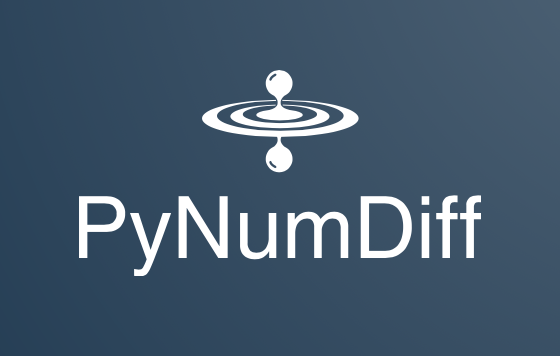Python methods for numerical differentiation of noisy data, including multi-objective optimization routines for automated parameter selection.
PyNumDiff is a Python package that implements various methods for computing numerical derivatives of noisy data, which can be a critical step in developing dynamic models or designing control. There are four different families of methods implemented in this repository: smoothing followed by finite difference calculation, local approximation with linear models, Kalman filtering based methods and total variation regularization methods. Most of these methods have multiple parameters involved to tune. We take a principled approach and propose a multi-objective optimization framework for choosing parameters that minimize a loss function to balance the faithfulness and smoothness of the derivative estimate. For more details, refer to this paper.
PyNumDiff/
|- README.md
|- pynumdiff/
|- __init__.py
|- __version__.py
|- finite_difference/
|- kalman_smooth/
|- linear_model/
|- smooth_finite_difference/
|- total_variation_regularization/
|- utils/
|- optimize/
|- __init__.py
|- __optimize__.py
|- finite_difference/
|- kalman_smooth/
|- linear_model/
|- smooth_finite_difference/
|- total_variation_regularization/
|- tests/
|- examples
|- 1_basic_tutorial.ipynb
|- 2a_optimizing_parameters_with_dxdt_known.ipynb
|- 2b_optimizing_parameters_with_dxdt_unknown.ipynb
|- docs/
|- Makefile
|- make.bat
|- build/
|- source/
|- _static
|- _summaries
|- conf.py
|- index.rst
|- ...
|- setup.py
|- .gitignore
|- .travis.yml
|- LICENSE.txt
|- requirements.txt
PyNumDiff requires common packages like numpy, scipy, matplotlib, pytest (for unittests), pylint
(for PEP8 style check). For a full list, you can check the file requirements.txt
In addition, it also requires certain additional packages for select functions, though these are not required for a successful install of PyNumDiff:
When using cvxpy, our default solver is set to be MOSEK (highly recommended), you would need to download their
free academic license from their website. Otherwise, you can also
use other solvers which are listed here.
The code is compatible with >=Python 3.5. It can be installed using pip or directly from the source code. Basic installation options include:
- From PyPI using pip:
pip install pynumdiff. May require pre-installingnumpy, scipy, matplotlib. - From source using pip git+:
pip install git+https://github.com/florisvb/PyNumDiff - From local source code using setup.py: requires pre-installing
numpy, scipy, matplotlib. Then runpython ./setup.py installfrom inside this directory. See below for example.
Installation of the optional packages such as cvxpy can be tricky because cvxpy requires pythonX-dev packages. Depending on your version of Ubuntu it can be challenging to meet all the right requirements and installation options (e.g. it is difficult to install python3.6-dev on Ubuntu 16.04). Here are several tested example installation workflows:
sudo apt-get install python3.5-dev
python3.5 -m venv ~/PYNUMDIFF35
source ~/PYNUMDIFF35/bin/activate
pip install --upgrade pip
pip install --upgrade pip
pip install git+https://github.com/florisvb/PyNumDiff
pip install git+https://github.com/pychebfun/pychebfun
pip install cvxpy
pip install git+http://github.com/MOSEK/Mosek.pipsudo apt-get install python3.6-dev
python3.6 -m venv ~/PYNUMDIFF36
source ~/PYNUMDIFF36/bin/activate
pip install --upgrade pip
pip install git+https://github.com/florisvb/PyNumDiff
pip install git+https://github.com/pychebfun/pychebfun
pip install cvxpy
pip install Moseksudo apt-get install python3.5-dev
python3.5 -m venv ~/PYNUMDIFF35
source ~/PYNUMDIFF35/bin/activate
pip install --upgrade pip
pip install --upgrade pip
pip install numpy scipy matplotlib
python ./setup.py install
pip install git+https://github.com/pychebfun/pychebfun
pip install cvxpy
pip install git+http://github.com/MOSEK/Mosek.pipNote: If using the optional MOSEK solver for cvxpy you will also need a MOSEK license, free academic license.
PyNumDiff uses Sphinx for code documentation. So you can see more details about the API usage there.
- Basic Usage: you provide the parameters
x_hat, dxdt_hat = pynumdiff.sub_module.method(x, dt, params, options) - Advanced usage: automated parameter selection through multi-objective optimization
params, val = pynumdiff.optimize.sub_module.method(x, dt, params=None,
tvgamma=tvgamma, # hyperparameter
dxdt_truth=None, # no ground truth data
options={})
print('Optimal parameters: ', params)
x_hat, dxdt_hat = pynumdiff.sub_module.method(x, dt, params, options={'smooth': True})`We will frequently update simple examples for demo purposes, and here are currently exisiting ones:
- Differentiaion with different methods: 1_basic_tutorial.ipynb
- Parameter Optimization with known ground truth (only for demonstration purpose): 2a_optimizing_parameters_with_dxdt_known.ipynb
- Parameter Optimization with unknown ground truth: 2b_optimizing_parameters_with_dxdt_unknown.ipynb
- Larger values of
tvgammaproduce smoother derivatives - The value of
tvgammais largely universal across methods, making it easy to compare method results - The optimization is not fast. Run it on subsets of your data if you have a lot of data. It will also be much faster with faster differentiation methods, like savgoldiff and butterdiff, and probably too slow for sliding methods like sliding DMD and sliding LTI fit.
- The following heuristic works well for choosing
tvgamma, wherecutoff_frequencyis the highest frequency content of the signal in your data, anddtis the timestep:tvgamma=np.exp(-1.6*np.log(cutoff_frequency)-0.71*np.log(dt)-5.1)
We are using Travis CI for continuous intergration testing. You can check out the current status here.
To run tests locally, type:
> pytest pynumdiff@ARTICLE{9241009, author={F. {van Breugel} and J. {Nathan Kutz} and B. W. {Brunton}}, journal={IEEE Access}, title={Numerical differentiation of noisy data: A unifying multi-objective optimization framework}, year={2020}, volume={}, number={}, pages={1-1}, doi={10.1109/ACCESS.2020.3034077}}
This project utilizes the MIT LICENSE. 100% open-source, feel free to utilize the code however you like.
